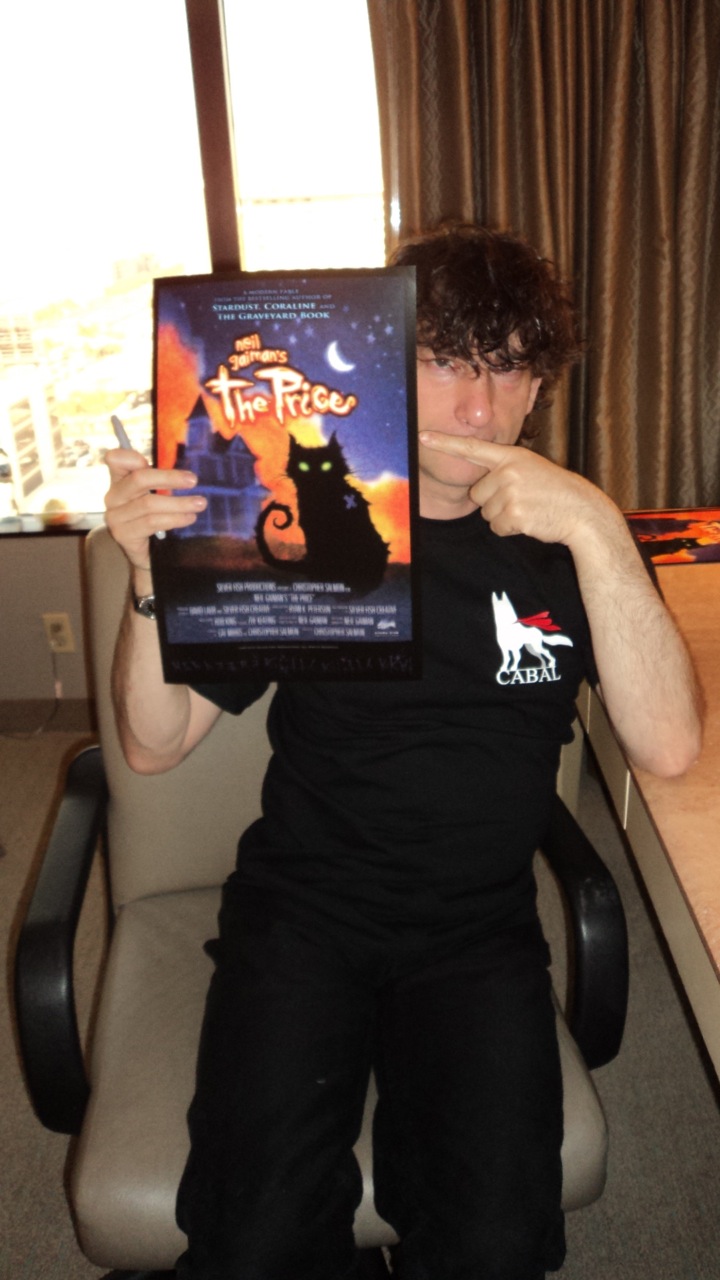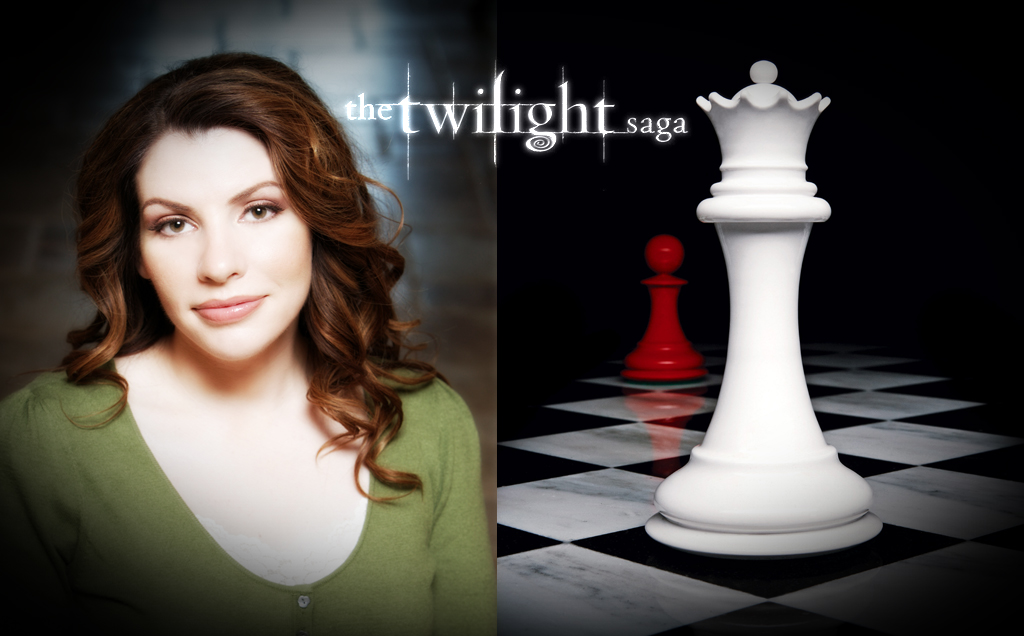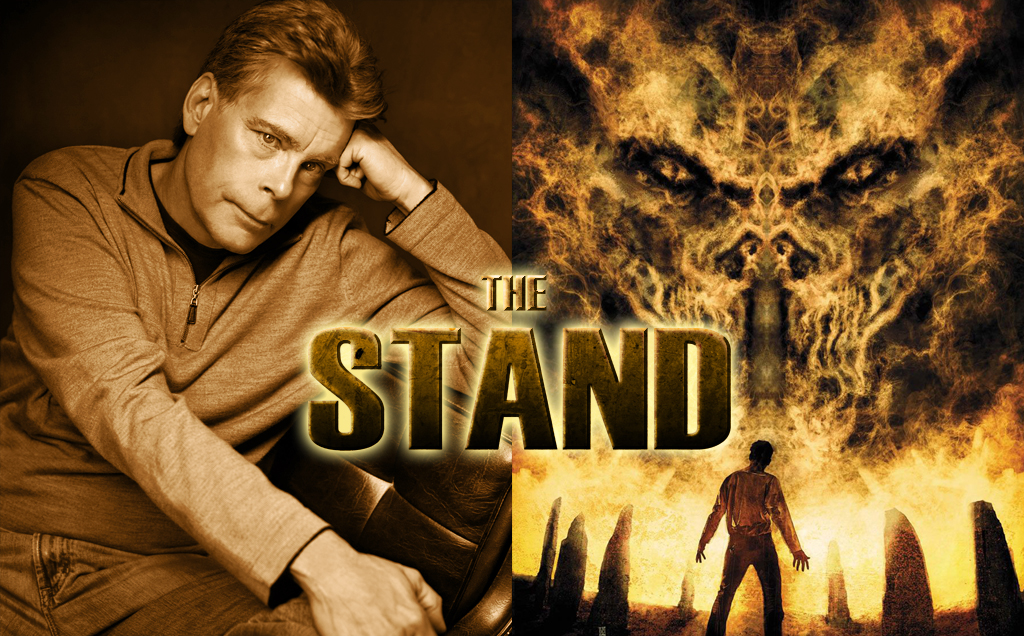Authors have always held an extremely special place in my life — they tell stories after all, and I love good stories more than almost anything. (That’s why I have always wanted to make movies; it’s the way I want to share my own stories with the world.)
If you are reading this blog, you already know how much the works of Mr. Neil Gaiman mean to me personally. Although vast numbers of people have written countless books and novels, it seems that only a handful can really tell a story. Neil’s sparkling imagination has such a distinctive, pleasing flavor; it has that wonderful feeling of being both fresh and familiar and skewed all at the same time. Mixed with a consistently charming attitude, his work sets him apart from everyone one else I’ve read. It’s as though he perceives the world from a slightly different angle, and has the ability to share what he sees with the rest of us; the man can tell a fantastic story.
I have yet to have the privilege of meeting him personally, but on March 1st I was fortunate enough to enjoy the company (along with about 400 others) of another of my favorite authors: Patrick Rothfuss.
(As you may recall from the last bit in my December post “The Magic Number,” Pat was watching The Price‘s Kickstarter campaign with a close eye.) If you haven’t yet read Pat’s 1st novel The Name Of The Wind, or the follow-up The Wise Man’s Fear (that recently hit the hallowed #1 spot on the NY Times Best Seller list), I suggest you go and do so … immediately!
It was great fun to see him, as depicted in the video clip below, taken on the first night of his promotional tour for The Wise Man’s Fear at the University Bookstore in Seattle … have a peek:
Patrick Rothfuss Signing “The Wise Man’s Fear” from Christopher Salmon on Vimeo.
His insights on story development, character/world building and his rationale for why it took so long (3+ years) to finish the 2nd volume were inspirational and profound. However, it was his extremely deft handling of a few clumsy questions regarding stylistic choices — along with naked requests to explain his storytelling motives — that left me in respectful awe. He was neither coerced into revealing things best left to be discovered by readers themselves, nor did he make those who proffered these queries look like the buffoons the rest of us had quickly judged them to be.
For example, someone actually asked: “So how come the Prologues and Epilogues in both of your books are practically identical? Like pretty much the same words and everything?” As one, the crowd turned to look upon this uncouth swine with baleful eye and searing disdain … when Pat said, “You know, a book is really a living thing. You are asking me to dissect it for you, and anytime you dissect a living thing … it dies. So I’m sorry, but I won’t answer that.” Gently followed by, “Next?” The swelling animosity was leeched away almost immediately and the wonderful vibe that had seemed lost just moments before was restored. Quite wonderful.
I also had the opportunity of meeting Stephanie Meyer a few years ago at a BYU Symposium held in nearby Provo, Utah. It was organized primarily for librarians and not for the general public, but I had taken my daughter down to the clandestine location (the hard-won result of much sleuthing along with the relentless questioning of several bookstore employees) in hopes we might find a way to party-crash, and possibly get our 2 books signed (New Moon had only just been released at this point). As we entered the building (trying unsuccessfully not to look both guilty and conspicuous), we haphazardly met a mother and daughter that were leaving and who graciously offered their lanyard pass cards to us. Delighted at our good fortune, we happily snuck in to hear Stephanie’s lecture — me blithely wearing a tag declaring its owner to be “LORI.”
I was enchanted as Stephanie described the creative process and corresponding journey of self-discovery that accompanied the writing of her first (and now ubiquitous) novel. (And whatever you may think of the Twilight series yourself, I can vouch for the author’s pure desire to release a story that had genuinely captured her heart and invaded her dreams with an impassioned fervor.)
While waiting in the attendee’s signing line after the presentation was finished, we started chatting with the lady in front of us (a librarian, of course), who began the conversation with a politely pointed comment on my name tag. After ‘fessing-up to our deception and receiving only good-natured amusement in return, we became so caught-up in a discussion on the literary veracity of “Lori” as a man’s name (see Little Women — although in all fairness, the character’s name is spelt “Laurie”), that I failed to notice a security guard making her way down the line and checking everyone’s lanyard for the appropriate I.D. Luckily, my daughter Jaydrian had the presence of mind to nonchalantly flip my tag over so that only the generic back side remained visible. Sparing only a proverbial passing-glance, the security worker continued along without hesitation, and it was only then that Jayd was able to catch my full attention and reveal how close the call had been.
At any rate, Stephanie was very generous with her fans and complimented me as a parent for taking time to read some of the same things that my child was reading. Not surprisingly, I took the opportunity to ask her about the (then) forthcoming movie-adaption of Twilight, specifically concerning what techniques the filmmakers were planning to use to realize the vampiric nature of her creations. I explained (and still vehemently maintain) that best way would have been to use CG imagery to convey the physical perfection, otherworldly abilities and the unnatural movements of Edward and his kind. Ironically, these are some of the very hallmarks of CG animated humans that are normally considered undesirable and read onscreen as “false,” which could have (in this instance) created exactly the “not quite human” quality needed to give credibility to the existence of the undead — much more so than a bunch of pretty, sullen faces caked with makeup ever could. She mentioned that the producers had considered something along those lines at one point … but alas …
Finally, way back in 1993 I had a chance to volunteer with the special effects make-up department for the miniseries The Stand while they were filming on location here in Utah. Depicting the apocalyptic aftermath of a genetically engineered super-flu required the ‘wrangling’ of dozens of fabricated corpses in many of the scenes, and I was more than happy to lend a hand while standing in the middle of a city dump location during a constant drizzle if that meant getting a chance to glimpse the man himself: Stephen King.
I had met and been welcomed by the makeup effects team after stumbling unannounced into their trailer/workshop one afternoon. I had actually attempted to sneak onto the closed set, when yet another security enforcer appeared (out of nowhere, naturally) and asked me where I thought I was going.
“To the Makeup Effects trailer!” I blurted, off the cuff. His eyes narrowed as he pointed to one of many trailers lined up in an abandoned lot across the street. “Well, it’s right over there,” he said with a firm, intense tone.
“Great. Thanks!” I tried to appear relieved — grateful, even — and quickly began to walk in the appropriate direction. I spared one last glance over my shoulder to see if the guard was still watching before fully committing to the charade; he was, so taking a breath, I plunged inside.
To his credit, effects artist Joel Harlow just looked up from the sculpture he was working on and said easily, “Hey, man.” He and the other guys on the crew got a chuckle over of my lame story, and invited me to help out while regaling me with many wonderful industry-insider stories that ‘squids’ (geek fan-boys like myself) just can’t get enough of.
Despite their warm camaraderie and obtaining official permission to be on set with them, I was sternly warned about ever approaching Stephen King (who was present for much of the production). Violating this cardinal rule was grounds for immediate set expulsion, no exceptions.
I was bummed of course; that was the biggest reason I had hoped to get on set in the first place: to meet my very first ‘favorite’ storyteller. But there was still enough to keep me excited each time I was able to join the crew (blowing-up houses, seeing Molly Ringwald and Rob Lowe, helping to puppeteer a cable-operated, talking corpse), but still … at least I had the guys’ promise to introduce me to Stephen if the right opportunity arose.
Then one very late night/early morning (around 2 am), who suddenly steps into the makeup trailer, but Mr. King himself. I even had to step to one side so that he could walk to the far end of the narrow space, making his way over to a small table heavy-laden with more than 2 dozen hardcover copies of the ‘unedited’ version of The Stand (running some 1100+ pages in length). I tried not to stare, but … it was really him, you know? And then I noticed how weary he seemed as he sat down and began to sign the first of many large volumes. He smiled tiredly and kept up the pleasant small talk with his host, but the lateness of the hour and the fact that this was all part-and-parcel of his celebrity was not lost on me.
Although I didn’t get to meet him that night, it wasn’t too many days later that I found myself sitting in a nondescript white van getting ready to head into the stinky depths of the Ogden City Dump for the day’s filming, when the author jumped into the passenger seat to catch a ride down with us. I tried in vain to recall how I did that ‘breathing’ thing … and what the heck was my name again, anyway??!!
And suddenly, it was happening: one of the FX crew, Dave Dupuis, introduced me and Stephen leaned over the seat, stuck out his hand, and said affably, “Hi. Steve King.”
I’m sure I gibbered something.
Later on, as filming slowly progressed and we all tried to ignore both the constant rain and the implacable stench of our location, I saw him wandering alone off to the side of the set, walking slowly along a small creek and looking out across the valley to the mountains looming in the distance.
I won’t lie; I was sorely tempted to seize the moment and run over to speak with him — briefly, of course — since neither of us was busy at that moment and he was actually unaccompanied for once. This was it! The chance I had been waiting for, to tell him how very deeply his stories had affected my life, helping me through an awkward adolescence and providing so many solitary hours with genuine pleasure …
I’m sure you can imagine what I was hoping for, in my secret heart. I was the one, true fan that could reach him, and maybe he would sense how much his work really meant to me, and I would try not to get emotional, and we would somehow strike up an unlikely but enduring friendship …
… same old same old, right? Every fan’s dream.
Thankfully, that image of him wearily signing those books suddenly rose up in my mind and gave me pause. I started to think about how hard it might be to deal with the fact that every person you might ever meet after becoming ‘famous’ would want something from you. Maybe an autograph or a picture. Maybe just a moment of your time. But something; they would all want something.
So, I decided, I didn’t want to be just another one of many. I would wait and hope for a chance one day where perhaps I might be able to give something back instead of taking something away.
And here I am, years later with an opportunity to give something back. Mr. Gaiman has gone far beyond simply being generous to me (as has his wonderful assistant Cat Mihos), and I am bound-and-determined to pay them back, along with all of you wondrous people who believed enough in this project to pledge some of your hard-earned cash and help make this particular dream come true. Wow — sounds a lot like a happy ending, doesn’t it? And after all of the unexpected twists and turns, who could have guessed it?
That’s why I love stories …







Great post – thanks for taking the time to write this up! As Dumbledore said, “It is our choices, Harry, that show what we truly are, far more than our abilities.” Sometimes what you don’t do can be as important as what you do.
terrific stories– i absolutely love Mr. King’s vast imagination, i have grown up with his stories,
and I would also be hard-pressed not to ask a few choice questions. Drew & I recently rewatched THE STAND and were surprised at how well it stood up against the years. What would they do with it now, I wonder…
(THE TALISMAN is always a heart beat away—)
It is the right thing to do, to let the authors come to us. They have a great deal to carry around.
Thanks for sharing, CS!
Hi there! Christopher, I just wanted to let you know that I followed your advice and started reading The Name of the Wind, but now the book is stuck to my hands, and I am only able to unstick one hand to turn the pages, and to eat something now and then. Actually I am writing this comment with my nose hehe anyway, thank you!
Hah — you are most welcome (so glad I could ‘convert’ another poor, unsuspecting soul)!!!
Great post. Those are some good looking Salmon boys… the video of giving the gift was my favorite. Made me a tad misty. You rock.